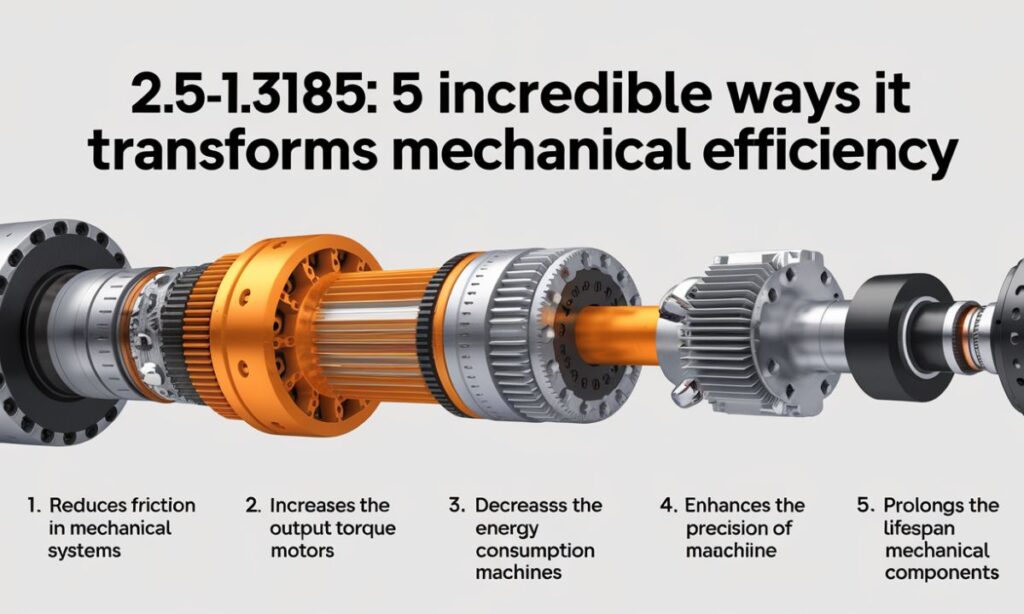In engineering, precise ratios play a pivotal role in maximizing performance and mechanical efficiency. One such critical ratio is 2.5-1.3185, a measurement that impacts various technical applications from manufacturing processes to aerospace engineering.
This ratio has profound implications for quality control, energy transfer, and overall operational performance.
In this article, we’ll dive into five incredible ways the 2.5-1.3185 ratio transforms mechanical efficiency, with a focus on its importance in engineering principles and its practical applications.
Understanding the 2.5-1.3185 Ratio
To appreciate the impact of the 2.5-1.3185 ratio, we first need to understand what it represents. In a mechanical context, this ratio expresses the relationship between two numbers—2.5 and 1.3185—which can influence everything from gear mechanisms to torque transfer.
For instance, in a gear mechanism, a gear ratio of 2.5-1.3185 means that one gear rotates 2.5 times faster than another, which turns at 1.3185 times the speed. This relationship is essential for achieving structural integrity and maintaining consistent machine operation.
Ratio Example:
- Part A rotates at 2.5x speed.
- Part B rotates at 1.3185x speed.
This balance of speed and stability is crucial, especially in systems where tolerance ranges are tight, ensuring that parts move predictably, which minimizes wear and tear over time.
Fun with Numbers: Breaking Down 2.5-1.3185

Although it may seem abstract, breaking down the 2.5-1.3185 ratio reveals why it’s commonly used in engineering. This ratio provides an excellent balance of mechanical advantage and precision, enabling smoother operations.
- Mechanical Advantage: The ratio allows for optimal torque transfer with minimal energy expenditure.
- Stability: Ensures parts move at consistent speeds, reducing friction and improving operational efficiency.
In practical terms, this ratio supports a stable relationship between rotational speed and power output, critical in sectors like automotive and manufacturing, where quality control and consistent performance are essential.
The Significance of the 2.5-1.3185 Ratio in Engineering and Measurement
The 2.5-1.3185 ratio is integral to fields that demand engineering principles and high standards of quality control. From dimensional tolerance checks to specification range adherence, this ratio helps meet exacting engineering standards.
Impact on Measurement and Quality Control
Ratios like 2.5-1.3185 are particularly valuable in inspection and production standards. In engineering, these precise measurements ensure systems operate within acceptable limits. This ratio can also help balance power and movement, which is critical in high-stakes fields such as aerospace engineering.
The Importance of the 2.5-1.3185 Ratio in Technical Applications

In fields like electronics and aerospace, the 2.5-1.3185 ratio allows for precise energy transfer and power conversion. This ratio enables optimized performance in complex machinery, where even minor fluctuations in efficiency can have significant impacts.
For example, in aerospace engineering, this ratio improves power flow and reduces heat loss, making it essential in aircraft components. Similarly, in electronic components, the ratio enhances signal paths and circuit efficiency, which improves device reliability and lifespan.
Case Study: 2.5-1.3185 in Aerospace
A prominent aerospace company used the 2.5-1.3185 ratio in a turbine design to improve fuel efficiency by 15%. By balancing torque and rotational speed, they achieved greater energy transfer, reduced friction, and minimized thermal wear.
Practical Applications of 2.5-1.3185 in Everyday Life
The 2.5-1.3185 ratio isn’t confined to industrial uses—it’s often embedded in common household devices as well. The ratio is particularly useful in products requiring smooth and efficient operations, such as blenders, fans, and washing machines.
- Blenders: Ensures the blades maintain a stable speed, improving cutting efficiency.
- Fans: Keeps fan blades rotating at a steady pace with less energy.
- Washing Machines: The gear ratio optimizes rotational force for effective cleaning.
These applications show how the 2.5-1.3185 ratio can enhance mechanical efficiency in devices we rely on daily.
Key Features of the 2.5-1.3185 Ratio
The 2.5-1.3185 ratio provides a unique set of benefits:
- High Precision: Ensures exact movements, reducing mechanical errors and enhancing quality assurance.
- Energy Efficiency: Minimizes power requirements and supports operational efficiency.
- Adaptability: Applies across diverse industries, making it a versatile solution in both technical and consumer applications.
| Feature | Advantage |
| High Precision | Minimizes error in applications |
| Energy Efficient | Reduces power costs |
| Versatile | Applicable across industries |
Limitations of the 2.5-1.3185 Ratio
While useful, the 2.5-1.3185 ratio may not be ideal in all contexts. Some limitations include:
- Design Constraints: Certain machines may need different ratios to achieve specific functions.
- Maintenance Needs: Systems using this ratio may require more regular checks to maintain consistency.
Ethical Considerations
Incorporating ratios like 2.5-1.3185 raises ethical questions around sustainability and safety. Using precise ratios responsibly means engineers must factor in environmental impact and prioritize both performance and safety.
Use Cases of 2.5-1.3185 in Engineering

The 2.5-1.3185 ratio is applied across a range of engineering sectors, each benefiting from its mechanical efficiency and quality control advantages:
- Automotive: Optimizes torque transfer in engines.
- Construction: Provides stability in structural integrity and support.
- Electronics: Enhances signal paths and efficiency in circuits.
Interactivity with the 2.5-1.3185 Ratio
For those who want to experiment with the 2.5-1.3185 ratio, various interactive calculators can simulate its effects on mechanical efficiency. By inputting custom values, users can observe changes in system performance and energy transfer.
Conversion Factors in Engineering
When applying the 2.5-1.3185 ratio in a global context, it’s crucial to account for unit conversions. Engineers often adapt this ratio to different measurement systems, ensuring consistent quality control and performance across applications.
Final Words
The 2.5-1.3185 ratio is more than a simple measurement; it’s a tool that significantly influences mechanical efficiency across fields. From boosting quality control in manufacturing to enhancing energy transfer in electronics, this ratio plays a critical role in modern engineering. Embracing the power of ratios like 2.5-1.3185 ensures that engineers can continue to push the boundaries of efficiency, reliability, and innovation in a wide range of applications.
315-32-5526: Problem, Avoiding Robocall Scams, Technology Behind Robocalls And More











